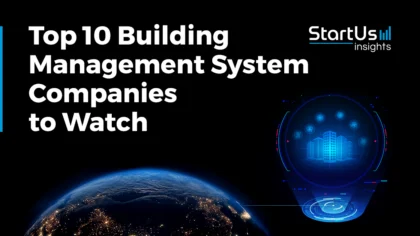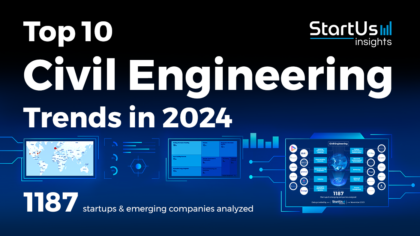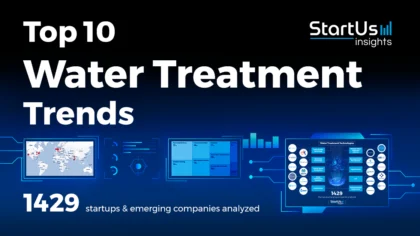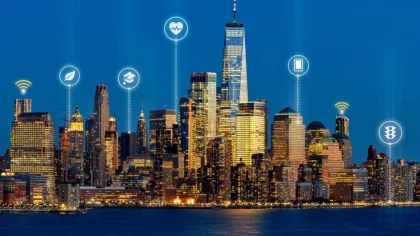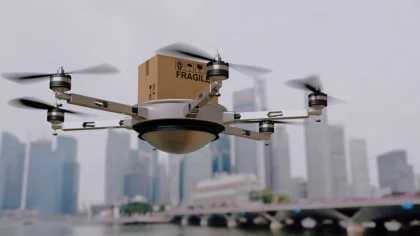Smart cities evolve as innovative technologies address challenges like urban congestion, resource management, and infrastructure inefficiencies. This report examines emerging smart city technology, showing how they transform urban environments. For instance, AI, big data, and analytics optimize traffic flow and energy consumption, while CleanTech promotes sustainable practices in waste management and energy use. Immersive technologies, such as augmented reality (AR), enhance urban experiences by introducing AR-driven solutions for smart cities and tourism as seen through Augemented.City’s AC Tourist.
Moreover, the internet of things (IoT) improve public services and infrastructure management. For instance, EoH’s IoT solutions enhance connectivity, sustainability, and public infrastructure management. Blockchain ensures secure data transactions, and robotics and nanotechnology contribute to advanced maintenance and security systems. Cloud computing facilitates data storage and accessibility, and VR technologies provide immersive training and planning tools. As these technologies reshape urban environments, stakeholders must adapt to remain competitive, meet the growing demands of urban populations, and overcome current challenges.
Why should you read this report?
- Gain insights into the top 10 smart city technologies.
- Learn about three practical use cases for each technology.
- Meet 10 innovative startups advancing these technologies.
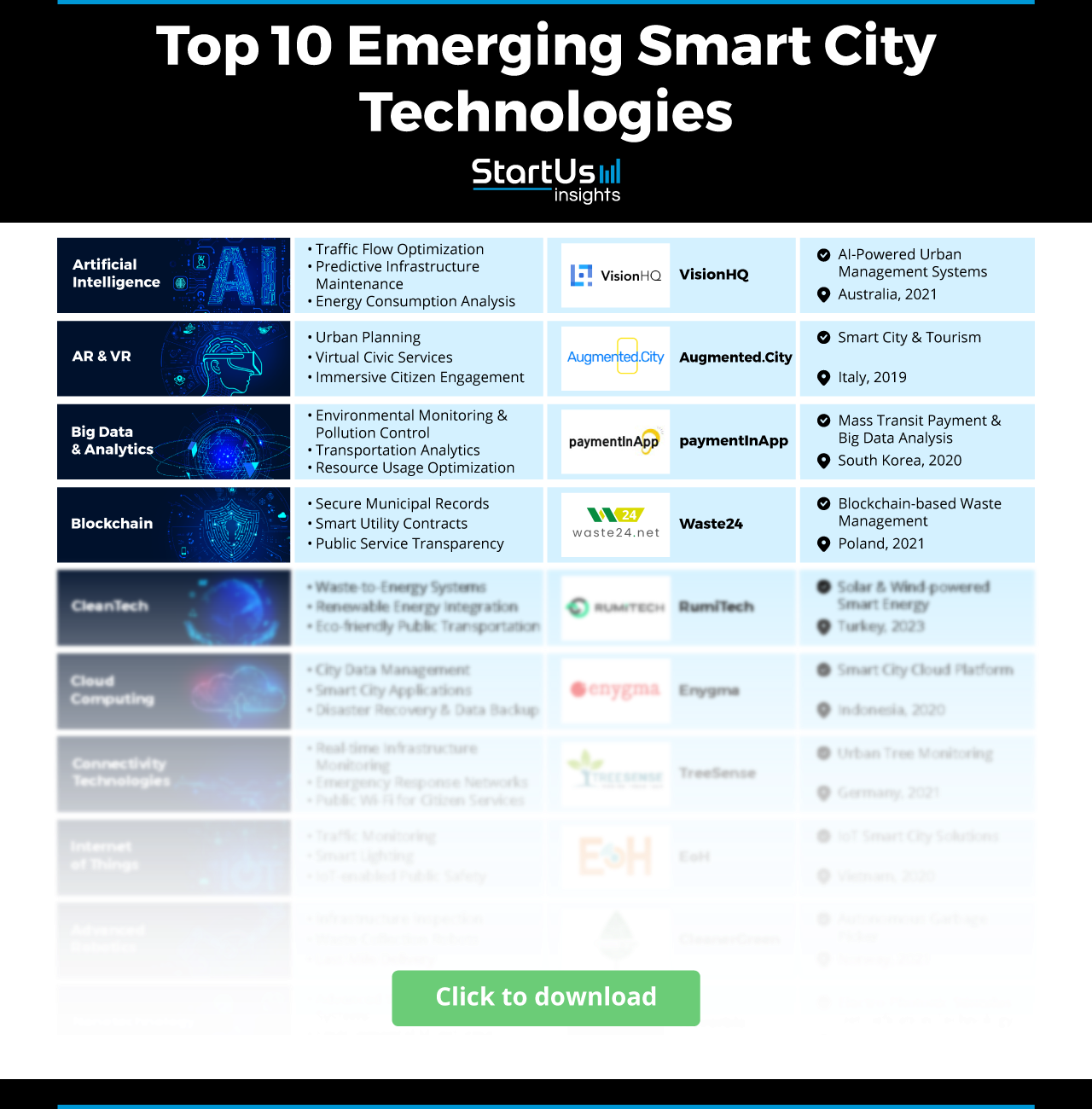
Key Takeaways
- Artificial Intelligence (AI)
- Use Cases:
- Traffic Flow Optimization
- Predictive Infrastructure Maintenance
- Energy Consumption Analysis
- Startup to Watch: VisionHQ
- Use Cases:
- Augmented Reality (AR) & Virtual Reality (VR)
- Use Cases:
- Urban Planning
- Virtual Civic Services
- Immersive Citizen Engagement
- Startup to Watch: Augmented.City
- Use Cases:
- Big Data & Analytics
- Use Cases:
- Environmental Monitoring & Pollution Control
- Transportation Analytics
- Resource Usage Optimization
- Startup to Watch: paymentInApp
- Use Cases:
- Blockchain
- Use Cases:
- Secure Municipal Records
- Smart Utility Contracts
- Public Service Transparency
- Startup to Watch: Waste24
- Use Cases:
- CleanTech
- Use Cases:
- Waste-to-Energy Systems
- Renewable Energy Integration
- Eco-friendly Public Transportation
- Startup to Watch: RumiTech
- Use Cases:
- Cloud Computing
- Use Cases:
- City Data Management
- Smart City Applications
- Disaster Recovery & Data Backup
- Startup to Watch: Enygma
- Use Cases:
- Connectivity Technologies
- Use Cases:
- Real-time Infrastructure Monitoring
- Emergency Response Networks
- Public Wi-Fi for Citizen Services
- Startup to Watch: TreeSense
- Use Cases:
- Internet of Things (IoT)
- Use Cases:
- Traffic Monitoring
- Smart Lighting
- IoT-enabled Public Safety
- Startup to Watch: EoH
- Use Cases:
- Advanced Robotics
- Use Cases:
- Infrastructure Inspection
- Waste Collection Robots
- Last-Mile Delivery
- Startup to Watch: CleanerGreen
- Use Cases:
- Nanotechnology
- Use Cases:
- Advanced Water Filtration Systems
- Environmental Monitoring
- Nanomaterials in Construction
- Startup to Watch: Novorbis
- Use Cases:
Smart City FAQs
How big is the smart cities market?
The global smart cities market is growing rapidly due to urbanization and the adoption of advanced technologies. Recently valued at over USD 500 billion, industry projections estimate the market could exceed USD 1 trillion by 2028. Investments in infrastructure, IoT devices, data analytics, and sustainable smart city solutions drive this growth to enhance urban living and efficiency.
What is the future of smart city technology?
Smart city technologies are transforming urban environments through AI, the Internet of Things, 5G connectivity, and sustainable solutions. These cities leverage AI and machine learning for real-time data analysis to improve services such as traffic management, energy consumption, and public safety.
Further, the increase in IoT devices creates interconnected infrastructure and services. Deploying 5G networks supports high-speed data transmission needed for these applications, while a focus on sustainability drives the adoption of smart grids and renewable energy sources.
How We Identify Emerging Technologies & Startups
The data in this report originates from StartUs Insights’ Discovery Platform, covering 4.7+ million global startups, scaleups, and technology companies, alongside 20K+ emerging technologies and trends. Our platform makes startup and technology scouting, trend intelligence, and patent searches more efficient by providing deep insights into the technological ecosystem. Utilizing the trend intelligence feature, we analyze industry-specific technologies for this report, detect patterns and trends, and identify use cases along with the startups advancing these areas. Further details and capabilities are accessible via the website.
10 Emerging Technologies Impacting the Future of Smart Cities [2025 & Beyond]
1. Artificial Intelligence

AI technologies play a vital role in smart cities by processing vast amounts of data to optimize urban operations. Machine learning algorithms process large amounts of data to uncover patterns that improve resource management, while deep neural networks enable predictive analytics, allowing government officials to anticipate and respond to urban trends. Further, natural language processing (NLP) enhances communication systems by interpreting human language data, making information dissemination more efficient. Meanwhile, computer vision analyzes visual data from sensors and cameras, supporting the monitoring and maintenance of city infrastructure.
3 Practical Use Cases of Artificial Intelligence in Smart Cities:
- Traffic Flow Optimization: AI analyzes data from sensors and cameras to adjust traffic signals in real-time enabling the reduction of congestion and improving travel times.
- Predictive Infrastructure Maintenance: AI predicts infrastructure wear and tear by analyzing sensor data from bridges, roads, and tunnels to allow for proactive maintenance, thus avoiding failures and minimizing disruptions.
- Energy Consumption Analysis: AI-driven energy monitoring systems track and analyze usage patterns in real-time, eqioing digital cities with the information they need to optimize energy distribution and enhance efficiency.
Startup to Watch: VisionHQ
Australian startup VisionHQ develops AI and computer vision solutions to transform urban management with smart insights that extend the life of city infrastructure. Its AI-powered Road Monitoring System collects real-time data of road conditions to detect damage and prioritize repairs. The AI-powered Road Contamination Detection solution identifies waste contamination sources to enable efficient waste management and resource allocation. Further, the AI-powered Street Waste Detection system detects debris and hazards on streets to improve urban cleanliness and safety.
2. Augmented Reality & Virtual Reality

AR devices like Microsoft’s HoloLens and Magic Leap enable spatial computing by blending digital information with the physical world, improving urban planning and infrastructure management. Deploying 5G networks provides the low-latency, high-bandwidth connectivity necessary for seamless AR and VR experiences across cityscapes. For example, VR leverages headsets equipped with high-resolution displays, motion sensors, and haptic feedback systems to create immersive virtual environments for urban planning and citizen engagement. AI-powered computer vision and LiDAR sensors further enhance real-time data visualization and environmental mapping, enabling more dynamic urban settings. Moreover, edge computing optimizes these technologies by processing data closer to its source, reducing latency and improving efficiency in densely populated areas.
3 Practical Use Cases of AR & VR in Smart Cities:
- Urban Planning: Urban planners visualize construction projects through a 3D model, accurately assess how new developments will integrate with existing city infrastructure, and easily gather feedback from stakeholders.
- Virtual Civic Services: Immersive, interactive experiences for accessing government services enable citizens to complete complex processes through virtual guidance, improving data completeness and user experience.
- Immersive Citizen Engagement: AR and VR encourage a participatory urban development by enabling citizens to explore virtual city models, interact with proposed changes, and provide informed feedback on urban projects.
Startup to Watch: Augmented.City
Italian startup Augmented.City develops AC Tourist, an augmented reality cloud platform for creating city-scale tourism AR experiences. The platform captures real-world data, enriches it with contextual information, and visualizes it through mobile devices, offering interactive urban experiences. AC Tourist includes AR-based city guides and real-time tourist information while integrating with smart city infrastructure. Through its solutions, Augmented.City improves urban exploration, cultural engagement, and tourism experiences.
3. Big Data & Analytics

Big Data and analytics play a key role, driving smart city development by transforming urban data into actionable insights. For example, IoT sensors and devices collect real-time information from city infrastructures while cloud and edge computing platforms store and process this data. Machine learning algorithms and AI then analyze this data to recognize patterns and trends, enabling informed decision-making. Lastly, data integration tools ensure seamless communication between systems, while data visualization technologies make complex datasets accessible.
3 Practical Use Cases of Big Data & Analytics in Smart Cities:
- Environmental Monitoring & Pollution Control: Real-time monitoring of environmental pollutants in smart cities is achieved by collecting and analyzing sensor data. This informs policy decisions and aids in reducing greenhouse gas emissions.
- Transportation Analytics: Detailed insights on traffic patterns and public transit efficiency enable cities to optimize routes and reduce congestion through predictive models.
- Resource Usage Optimization: Big data supports smart cities in optimizing energy and water usage by analyzing consumption patterns that enable more efficient resource management and reduced waste.
Startup to Watch: paymentInApp
South Korean startup paymentInApp provides a mobile transit payment system designed for smart cities. The platform supports multiple payment methods, including EMV credit cards, QR codes, and mobile payments, allowing for seamles transactions in public transportation. By leveraging AI and machine learning, the system monitors real-time passenger data, analyzing movement patterns, demographics, and payment types to forecast demand, optimize routes, and enhance operational efficiency. paymentInApp improves transparency, scalability, and profitability in urban transit systems, ultimately enhancing public transportation experiences and infrastructure management.
4. Blockchain

Blockchain, enabled by distributed ledger technology (DLT), ensures that infrastructure data and citizen records are accurate and tamper-proof by recording and synchronizing data across multiple nodes. Smart contracts, based on blockchain, streamline city management by automating complex processes through predefined actions when certain conditions are met. They thereby reduce administrative overhead and minimize human error. Moreover, decentralized applications (dApps) create open platforms for city services to foster innovation and collaboration among stakeholders.
3 Practical Use Cases of Blockchain in Smart Cities:
- Secure Municipal Records: Municipal records are stored securely and tamper-proof by creating an immutable ledger that ensures data integrity and prevents unauthorized alterations.
- Smart Utility Contracts: The automated execution of smart utility contracts through decentralized systems ensures transparency, accuracy, and timely payments without intermediaries.
- Public Service Transparency: Blockchain improves public service transparency by providing an open, decentralized platform where citizens can access and verify service-related data to increase accountability within governmental organizations.
Startup to Watch: Waste24
Polish startup Waste24 develops Waste24.net, a blockchain-based waste management platform that enhances efficiency and transparency in the waste collection processes. The platform integrates smart contracts with IoT-enabled ultrasonic sensors to monitor container fill levels in real-time, automatically scheduling waste pickups. The startup’s blockchain integration ensures secure communication between smart devices and the central system, providing verifiable records of waste-handling events and access control for employees. This system reduces operational costs, improves resource allocation, and enables real-time data tracking, leading to optimized waste management and better recycling outcomes. Waste24’s solution helps municipalities and waste companies streamline operations and maintain environmental compliance.
5. CleanTech

Renewable energy technologies, including solar panels and wind turbines, are increasingly being integrated into urban environments to generate clean power and reduce reliance on fossil fuels. Advanced energy storage systems, including next-generation batteries, enable cities to store surplus energy and balance supply during peak demand. Additionally, smart grids equipped with real-time monitoring and management tools optimize energy distribution, ensuring efficient and sustainable power use. CleanTech also includes innovations in waste management and water conservation, leveraging technologies like sensor-driven recycling systems and advanced filtration methods to reduce waste and minimize pollution.
3 Practical Use Cases of CleanTech in Smart Cities:
- Waste-to-Energy Systems: Advanced processes like anaerobic digestion and gasification transform municipal waste into energy to reduce landfill dependency and generate renewable electricity and heat for urban areas.
- Renewable Energy Integration: Smart grids and energy storage solutions optimize the use of solar, wind, and bioenergy sources to ensure continuous, sustainable power in smart cities.
- Eco-friendly Public Transportation: Electric and hydrogen-powered vehicles reduce emissions and enhance air quality while maintaining efficient urban mobility.
Startup to Watch: RumiTech
Turkish startup RumiTech develops solar and wind-powered smart energy solutions that integrate renewable energy with IoT technology to enhance urban infrastructure. The startup’s RumiHWS24 system combines solar panels and wind turbines to produce off-grid energy, stored in lithium batteries and controlled via hybrid MPPT and wind turbine controllers. Its solutions support applications like smart lighting, CCTV, and emergency communication, all managed remotely through IoT connectivity. RumiTech harnesses sustainable energy sources to reduce carbon emissions and operational costs and offers a scalable and environmentally friendly energy solution for smart cities.
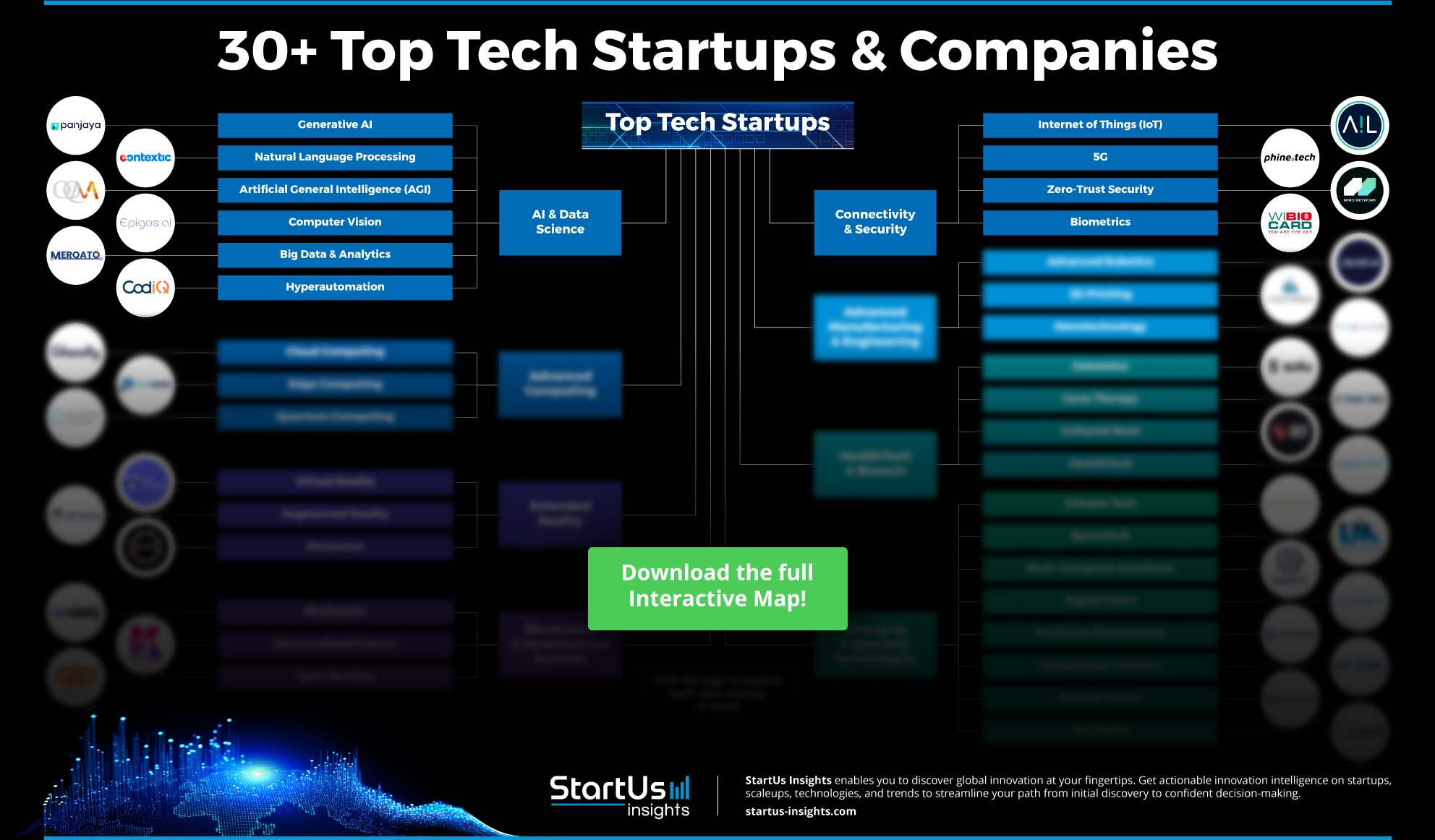
6. Cloud Computing

Technologies like edge computing and hybrid cloud architectures enable real-time data analysis. This feature enhances the responsiveness of city services by decentralizing data storage and computation closer to the source. Moreover, cloud platforms integrate with AI and IoT networks, allowing cities to collect, analyze, and respond to data from sensors, traffic systems, and public utilities. These cloud-based solutions also strengthen cybersecurity by employing advanced encryption methods and decentralized access controls to protect sensitive information.
3 Practical Use Cases of Cloud Computing in Smart Cities:
- City Data Management: Cloud computing provides scalable processing and storage power for large volumes of urban data. This enables cities to integrate real-time analytics and improve decision-making.
- Smart City Applications: Hosting diverse platforms like IoT systems, big data analytics, and SaaS applications, cloud computing supports the optimization of resources and delivery of better services to citizens.
- Disaster Recovery & Data Backup: Cloud-based solutions ensure that cities quickly restore critical data and applications during outages. Thereby, they reduce downtime and ensure operational continuity in a cost-effective, scalable manner.
Startup to Watch: Enygma
Indonesian startup Enygma offers smart city solutions, including a web-based GIS and data visualization platform that centralizes urban data for real-time analysis. Its IoT and surveillance camera systems integrate multiple data streams for efficient monitoring and data collection, with image processing capabilities that enable real-time image analytics. Enygma’s Paperclip product provides cloud-based management solutions, while the Smart Citizen App facilitates direct engagement between citizens and city services, enhancing community participation and urban efficiency.
7. Connectivity Technologies

Advanced technologies like 5G networks enable real-time interactions across urban systems, including traffic management and emergency services. Wi-Fi 6 improves connectivity by providing higher speeds and enhanced bandwidth in densely populated areas to ensure uninterrupted access for citizens and city systems. Low power wide area networks (LPWAN) such as LoRaWAN offer cost-effective, long-range connectivity for IoT devices, which allows for efficient monitoring and management of city infrastructure.
3 Practical Use Cases of Connectivity Technologies in Smart City
- Real-time Infrastructure Monitoring: Low-power, long-range wireless sensors continuously collect data on structural conditions to enable proactive maintenance and rapid response to potential issues.
- Emergency Response Networks: IoT-based sensors and 5G networks facilitate rapid communication and data sharing between emergency services to improve response times and coordination during crises.
- Public Wi-Fi for Citizen Services: Public Wi-Fi provides residents with seamless access to online services to enhance digital inclusion and support real-time access to city resources and information.
Startup to Watch: TreeSense
German startup TreeSense develops sensor technology for urban tree monitoring, focusing on improving tree health through data-driven insights. The TreeSense Pulse sensor measures the water balance within trees by tracking electrical resistance and temperature which allows for early detection of drought stress. It operates autonomously using LoRaWAN or NB-IoT networks and ensures energy-efficient data transmission. Further, continuous monitoring enables proactive irrigation planning, evaluation of tree care measures, and data-driven decisions. Integrated with TreeSense Cloud, the system visualizes sensor data in real-time to offer actionable insights to promote sustainable urban forestry. TreeSense supports efficient resource use and enhances long-term tree vitality management.
8. Internet of Things

Sensor networks, RFID, and machine-to-machine (M2M) communication form the backbone of the IoT, enabling the monitoring and optimization of infrastructure, utilities, and public services. Edge computing further enhances IoT efficiency by processing data closer to its source, reducing latency and improving response times for critical applications. What’s more, IoT platforms leverage cloud integration and AI-driven analytics to process large data volumes, providing actionable insights that support intelligent decision-making in urban environments.
3 Practical Use Cases of the Internet of Things in Smart Cities:
- Traffic Monitoring: Networked sensors and cameras collect and analyze traffic data to improve congestion management and support predictive infrastructure maintenance.
- Smart Lighting: IoT-powered smart lighting systems use connected sensors to adjust street lighting based on actual activity levels. This enhances energy efficiency and improves public safety by responding to environmental changes or emergencies.
- IoT-enabled Public Safety: IoT enhances public safety by integrating sensors, cameras, and communication networks. These systems detect incidents, monitor environments in real-time, and facilitate rapid emergency response to ensure proactive protection in urban spaces.
Startup to Watch: EoH
Vietnamese startup EoH develops IoT-powered smart city solutions that improve connectivity, sustainability, and public infrastructure management. Its flagship product, the EoH Gateway All In One (Model: EG-AIO-01), connects smart sensors and devices via Zigbee, Bluetooth, 2G/3G/4G, Ethernet, Modbus RTU, and CAN Bus. This enables data collection and transfer to a centralized management platform. The EG-AIO-01 supports diverse communication protocols that allow monitoring and analyzing various data streams in real-time. Its applications include smart street lighting, parking systems, and public safety to enhance operational efficiency and environmental sustainability in urban environments.
9. Advanced Robotics

Autonomous mobile robots (AMRs) operate without human intervention, improving logistics and maintenance operations in smart cities. These advanced robotics systems leverage AI and machine learning for better decision-making, adapting to changing environments, and handling complex tasks. Plus, collaborative robots, or cobots, work alongside human workers in construction and public services to increase productivity and safety.
3 Practical Use Cases of Advanced Robotics in Smart Cities:
- Infrastructure Inspection: Sensor-powered autonomous drones and robots inspect bridges, tunnels, and other structures to ensure safety as well as reduce manual labor and human risk.
- Waste Collection Robots: Optimize waste collection routes, cut operational costs, and minimize environmental impact through precise sorting and disposal.
- Last-Mile Delivery: Autonomous robots offer faster, cost-effective, and eco-friendly last-mile delivery solutions to reduce delivery times and costs compared to traditional methods.
Startup to Watch: CleanerGreen
Norwegian startup CleanerGreen develops autonomous garbage picker robots to maintain clean urban environments. FESTIWALL-E, its first prototype, uses basic obstacle avoidance but lacks intelligent navigation, making it suitable for controlled environments like festivals. Ståle improves upon FESTIWALL-E by incorporating a camera system that enables it to autonomously recognize and pick up trash in urban outdoor areas. These robots operate day and night and contribute to cleaner cities by minimizing human involvement and reducing environmental impact.
10. Nanotechnology

Nanotechnology uses nanoscale materials and devices, such as nanomaterials and nano coatings, to improve the durability and functionality of urban infrastructure. These materials offer increased strength, self-cleaning properties, and better energy efficiency. Nanosensors monitor environmental conditions, energy consumption, and structural health, providing real-time data to optimize city operations. Moreover, nanotechnology intersects with emerging technologies like IoT and advanced materials to drive innovation in water purification, pollution control, and energy storage.
3 Practical Use Cases of Nanotechnology in Smart Cities:
- Advanced Water Filtration Systems: Nanomaterials such as carbon nanotubes and graphene-based membranes remove contaminants, heavy metals, and pathogens to provide cleaner water for urban populations.
- Environmental Monitoring: Nanosensors detect pollutants and toxic substances at a molecular level, allowing for real-time analysis and better pollution control in smart cities.
- Nanomaterials in Construction: Nano-silica and titanium dioxide enhance building materials through increased durability, elf-cleaning properties, and improved energy efficiency – making infrastructure more sustainable and resilient.
Startup to Watch: Novorbis
Indian startup Novorbis develops Electro-Photonic Stimulus Detoxification (EPSD) technology to reduce pollution by capturing harmful particulate matter. This technology uses electricity and light to purify pollutants like NOx, SOx, CO, PM2.5, and PM10 from the air. The startup applies EPSD in its filter-less Retrofit Emission Control Devices (RECDs), which are effective for diesel generators and industrial applications. EPSD captures pollutants and upcycles collected carbon into industrial products like black ink and nanotech coatings. Novorbis’ solutions improve air quality, promote sustainability, and contribute to a healthier environment.
Don’t Miss Out on the Latest Smart City Innovations
Ready to leverage the latest smart city technologies shaping the future? With StartUs Insights, you gain quick and easy access to over 4.7 million startups, scaleups, and tech companies, along with 20K emerging technologies and trends. Our AI-powered search and real-time database provide exclusive solutions that set you apart from the competition. Industry giants like Samsung, Nestlé, and Magna trust our innovation intelligence tools to lead trends, optimize operations, and uncover new market opportunities. Benefit from our unmatched data, comprehensive industry views, and reliable insights to drive strategic decision-making. Get in touch to learn how our tailored discovery options can accelerate your innovation journey.
Discover All Smart City Technologies & Startups!

